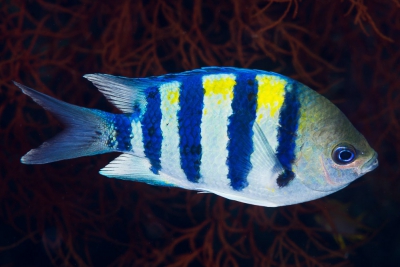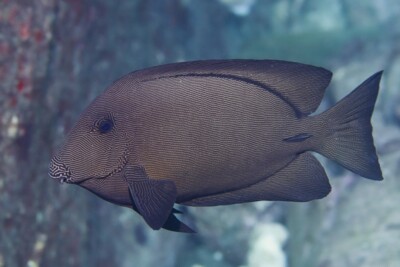squaretail bristletooth
| Family | Acanthuridae |
|---|---|
| Genus | Ctenochaetus |
| IUCN category (World) | LC |


Introduction
The Squaretail Bristletooth is a tropical marine fish native to the Indo-Pacific region. It is common from South Africa to Indonesia.
Who is it?
Morphology
-
Type
-
Average size14 cm
-
Maximum size16 cm
-
Longevity6 year
-
ShapeOvoid
-
Patternponctuations
-
Type
-
Average size14 cm
-
Maximum size16 cm
-
Longevity6 year
-
ShapeOvoid
-
Patternponctuations
How to recognize This fish ?
The squaretail Bristletooth is monochrome with a mostly brown body punctuated with pale yellow to white spots. This species is named after its truncated caudal fin in adults.
The body is laterally compressed and round in shape. The eye is encircled in yellow on the upper part. The pectoral fins are yellow. The dorsal, anal, caudal, and pelvic fins are slightly lighter than the body. The scalpel, located on the caudal peduncle, is the same color as the body.
Juveniles are yellow with a blue border on the dorsal and anal fins.
Sexual dimorphism
There is no apparent dimorphism in this species.
Behaviour & Life cycle
-
dietomnivorous with alguivorous tendency
-
Sociabilityliving in small groups
-
territorialYes
-
Way of livingdiurnal
The squaretail Bristletooth is a fish that lives in small groups. It is an active species that roams coral and rocky bottoms in search of algae to graze on.
Reproduction
-
Reproductiondont le mode de reproduction est encore inconnu
Reproduction is likely to be similar to that of other fish in the genus. It would occur seasonally with gamete release in open water. The larvae are pelagic and will feed on plankton.
Harmless species
This species does not pose a particular danger to humans in its natural habitat. However, one should be cautious of their scalpel.
Origin and distribution
What is its habitat?
Natural environment characteristics
-
Temperature22 - 28 °C
-
Depth1 - 21 m
Biotope presentation
The squaretail Bristletooth is most often found above reefs at depths less than 21 m. However, it is not impossible to find this fish at other depths.
Species of the same biotope
Main recommendations for fishkeeping
Deontology
In order to preserve wildlife, if you acquire this animal, it must not be released into the wild. See also, the Fishipedia charter.
Fishipedia supports the practice of responsible and environmentally friendly aquarium keeping. We encourage maintenance if it is motivated by a desire to understand the biological functioning of living things and if it is done with respect for animal life.
We believe that aquaristics is an opening to the discovery of aquatic environments, especially freshwater, and that this knowledge is necessary to better protect and respect these environments. Logically, we refute the compulsive purchase of animals that would not find a sufficient and / or adapted place in the host aquarium.
Our recommendations
-
Min volume300 liters
-
Population min1
-
Temperature22 - 28 °C
Characteristics
-
Difficulty breedinghard
-
Robustnesssensible
-
Behaviourslightly aggressive
-
Availabilityrare
General reminders
It is strongly advised to read the complete dedicated file and to get information on the feedbacks of maintenance of the envisaged animal, this to avoid any potential conflict whose end result is generally the death of the individual (or the other inhabitants). It is important not to overload your aquarium to limit pollution. This will make maintenance easier.
General reminder on maintenance datas
Le démarrage d'un aquarium est une partie primordiale pour l'équilibre et le bien-être des poissons. Lorsque l'on met en eau un aquarium, l'eau passe naturellement par un cycle biologique : le cycle de l'azote. Celui-ci dure environ trois semaines. Tous les 2 jours, nous vous conseillons de tester votre eau jusqu'à ce que le taux de nitrite soit à zéro pendant plusieurs jours d'affilée.
Pour accélérer ce cycle, vous pouvez utiliser un activateur de bactéries comme JBL Denitrol. Cette solution riche en bactéries vivantes et enzymes permet une mise en place rapide du cycle de l'azote. Les poissons peuvent alors être introduits plus rapidement.
Il est important de tester l'eau de son aquarium régulièrement pour maintenir un environnement sain pour les poissons et les autres habitants. Les tests d'eau permettent de mesurer les niveaux de différents paramètres tels que le pH, la dureté totale, ainsi que les taux de nitrates, de nitrites et d'ammoniaque.
Pour réaliser ces tests, vous pouvez utiliser des produits d'analyse spécialisés tels que JBL ProScan qui permet de réaliser un diagnostic de l'eau directement via un smartphone. Il existe également des coffrets de tests plus classiques de bandelettes, comme JBL PROAQUATEST.
En cas d’usage de l’eau du robinet, vous pouvez utiliser un conditionneur d’eau de type Biotopol de JBL pour éliminer les substances nocives comme le chlore, le cuivre, le plomb et le zinc. Une eau trop dure ou trop calcaire peut être inadaptée à de nombreuses espèces tropicales d’eau douce. Si nécessaire, vous pouvez la couper avec de l’eau osmosée ou de pluie filtrée afin d’obtenir une dureté plus adaptée aux besoins de vos poissons et de vos plantes. Les conditionneurs d'eau garantissent une meilleure santé aux poissons et une meilleure croissance des plantes.
Chlorine and chloramine are dangerous for the health of animals. Used to disinfect water, these agents are present in significant quantities in tap water. We recommend using an anti-chlorine agent every time you change the water. In addition to chlorine, treatments and medicines sold for aquarium use sometimes contain dangerous heavy metals in high doses.
Specific needs for the squaretail bristletooth
The squaretail bristletooth is a marine species which lives naturally at a temperature between 22 °C and 28 °C. The squaretail bristletooth is sensitive to abrupt changes in parameters as well as to chemicals. Its acclimation in an aquarium must be done with special care to prevent it from developing diseases or weaknesses. Nitrate levels should remain below 25mg/L. To keep the water clean and unpolluted, plan on changing 20% to 30% of the water volume each month. In seawater, it is also possible to remove nitrates using one of the following methods: Jaubert, denitrator on sulfur, biopeletts, vodka method.
The squaretail bristletooth is a species whose maintenance is rather reserved for informed aquarists . It can only be successfully carried out by carrying out a minimum of documentation work. Special husbandry conditions can easily lead to the death of the species or other animals.
This species is very rare in the aquarium trade. Instead, it is maintained by knowledgeable aquarists who own and breed individuals from wild origin strains. If you want to get this species, we advise you to contact specialized clubs. }Specimens from long time breeding are a bit easier to breed but you have to respect the particular water parameters.
Formal incompatibilities
Cohabitation & Environment
Being a living in small groups fish, it is advisable to install at least 1 individuals in an aquarium of 300 liters minimum. Group maintenance is a prerequisite to ensure their well-being. Lonely individuals tend to quickly become stressed and become especially susceptible to disease.
The squaretail bristletooth may show signs of aggression. In general, this species should not be mixed with large territorial species or other overly aggressive species, in order to avoid possible stress or even injury.
However, it can coexist with other species with a peaceful temperament and with some slightly territorial neighbors, as far as the volume of the aquarium allows. It is important to avoid that two territorial species share the same living area in an aquarium of insufficient volume.
Tips for feeding
The squaretail bristletooth is omnivorous with alguivorous tendency.
This species can eat dry food (flakes, pellets), fresh food and frozen food. To avoid deficiencies, it is recommended to vary the types of food.
Feed animals in moderation to maintain good water quality. Meals should be eaten within 2–3 minutes, served in several small portions rather than a single large ration.
Uneaten food quickly decomposes, releasing ammonia, nitrites, and nitrates, which disturb the aquarium’s biological balance.
Make sure each species can access food properly, slower or bottom-dwelling individuals may require targeted feeding.Reproduction protocol
-
egg-laying protectionNo
Hybridization risks
In general, it is advised not to mix several species of the same genus or different varieties of the same species, to avoid the risks of hybridization.
These animals might interest you
To go further
Sources & Contributions
Participation & Validation
The Fishipedia team and specialist contributors are committed to providing high-quality content. However, although the information comes from scientific sources or testimonials from specialists, the cards may contain inaccuracies.

Adrien Falzon
Translation
Translation done with the valuable contribution of our translators, who make this information available to a wider audience. We sincerely thank them for their commitment.
Bibliographic references
- - GBIF
- - Reef fish community in the Weh Island reef waters of Sabang, Aceh Province - Isa N. Edrus - Tri A. Hadi - Depik - 2020. https://core.ac.uk/download/pdf/290516487.pdf
Scientific partners
Tags
Species of the same family
Same genus
Species of the same biotope










































